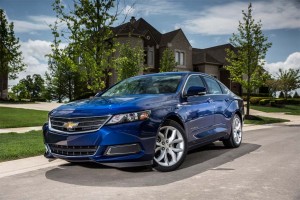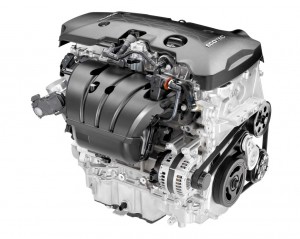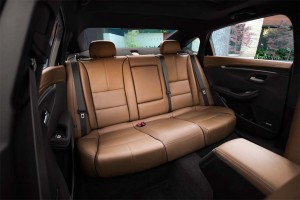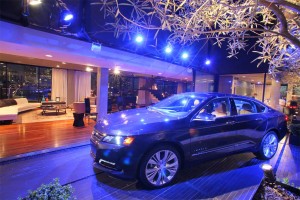Long known – and largely ignored – for its bland, forgettable styling and driving manners only a rental car customer could appreciate, General Motors delivered a real surprise with the redesigned 2014 Chevrolet impala.
As we discovered during our first drive of the sedan earlier this year, the new Impala is not just stylish and well-equipped but also a lot of fun to drive, not something you might expect from a 3,800-pound, full-size 4-door. Of course, it helped that the launch version of the Impala featured a peppy 3.6-liter V-6 turning out 305 horsepower and 264 pound-feet through a 6-speed automatic transmission.
In decades past, that might have been precisely what the market wanted, but not in an era of $4-a-gallon gas. Even big sedans like Impala now need to offer something smaller and more fuel-efficient under the hood. And the good news is the 2014 Chevy Impala has just the option, a new 2.5-liter inline-four that’s also matched up to a six-speed automatic.
If mileage is what matters, you’re likely to take a closer look at this offering, the 2.5-liter version of the Impala delivering 21 miles per gallon in the city and 31 mpg on the highway, compared to the V-6’s 19/29.
(Check out TDB’s review of the V-6 2014 Chevrolet Impala. Click Here.)
The Impala equipped with the 2.5-liter engine produces 196 hp and 145 lb-ft of torque, which while nowhere near as quick as the six-cylinder model is more than enough power to handle all kinds of driving situation, including highway on-ramps and high-speed passes. Though the Impala is big vehicle, it definitely does not feel at all sluggish when fitted out with the 2.5-liter engine and unlike some other GM cars of recent vintage the engine doesn’t sound as if its running out of steam as it revs up.
Mileage is one plus, but the price difference also is significant. GM has listed the V-6 at $30,760 while the 2.5-liter Chevrolet Impala has an MSRP of $27,535.
The 2014 Impala’s overall comfort and refinement are rooted in a stronger body structure. The stiffer architecture enabled engineers to tune the ride and handling more precisely, for a greater feeling of control and comfort, we found during several test drives of both the V-6 and I-4 models.
Safety equipment, meanwhile, includes 10 airbags, four-wheel-disc brakes and electronic stability controls as well as a rear facing camera to make parking easier. In addition, rear park assist, forward collision alert and lane departure warning are all available on the Impala.
(First Look: Kia’s big, luxurious new Cadenza. Click Here for the story.)
The exterior of the new full-size sedan is one of the stronger designs GM has brought to market in recent years – in fact, the fast redesign of the smaller Chevy Malibu picks up some of the key design cues of the Impala. The bigger sedan’s bold lines are reminiscent of the updated Camaro when it first appeared. The car has a low profile accentuated by horizontal lines that suggest strength.
The front fascia on the Impala is one of the very best versions of Chevrolet’s new global face we’ve yet seen. The low-profile projector-beam headlamps – or optional HID headlamps — and LED daytime running lights, which curve around the corners and frame the wide grille enhance the overall design of the Impala.
Besides adding to the car’s visual appeal, the new face also helps the 2014 Chevrolet Impala stand out in traffic, while 18-, 19- and 20-inch wheels available on Impala insure it has a bold stance both out on the road and when parked.
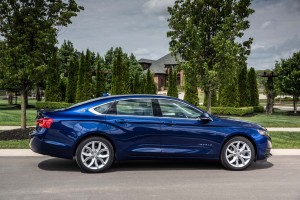
Chevy opted for a sleek, coupe-like design for the 2014 Impala, a big improvement over the old sedan's bland, boxy looks.
The design themes from the front are carried over to the distinctive rear fascia, which emphasizes character and overall visual appeal of the Impala. The swept look of the car’s long greenhouse also add to the car’s visual impact, while the mirrors, short rear decklid and tail lamps have been shaped for aerodynamic efficiency.
The Impala’s cabin is very quiet thanks to the use of acoustic laminated glass and triple-sealed doors. The interior is also spacious. Indeed any passengers riding in the rear seat might think the car is actually a limousine.
GM has put a lot of effort into upgrading the interiors of its passenger cars and the Impala clearly benefits from the effort. The space around the driver, which includes the wraparound instrument panel, is quite comfortable while the controls are easy to reach and the gauges easy to read at a glance. The Impala also offers excellent visibility from the driver’s seat.
The 2014 Chevrolet Impala is equipped with the Chevy MyLink infotainment system, which includes a Bluetooth hands-free cellphone connection, voice recognition, links to Pandora and storage space for up to 1,000 contacts as well as an easy-to-use interface. An eight-inch touch screen with concealed storage behind it is matched with MyLink on LT and LTZ models.
As with the V-6 model, the Impala with the new 2.5-liter I-4 drives like a much smaller car. The ride and handling are quite pleasing, while the brakes deliver both excellent stopping distance and very good pedal feel. The new electric power steering system delivers just enough feedback to offer a good sense of the road, which helps fortify the driver’s confidence in the car.
General Motors is an all-out bid to rebuild its reputation, which clearly took a tumble over the past decade. In fact, you could take things even further back. The maker’s once-dominant sedans have been little more than afterthoughts in recent years, relegated, as we mentioned, to rental car fleets. Chevrolet has had some success improving its position with the Malibu and now it is going after the full-size market.
It’ll be a challenge considering the range of alternatives – a number of which have also undergone updates during the last year. Despite the general downsizing of the U.S. market, there remains a viable market for full-size sedans, it would seem considering the latest versions of the Hyundai Azera and Toyota Avalon, along with the Nissan Maxima and Ford Taurus.
(Check out this review of the 2013 Toyota Avalon. Click Here.)
But for the first time in decades, GM has a viable response in the 2014 Chevrolet Impala. And with the addition of the new 2.5-liter I-4, it just might be the right choice for those who want a big car that doesn’t drink a lot of fuel.
Paul A. Eisenstein contributed to this report.

